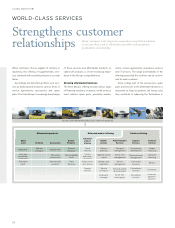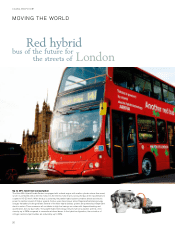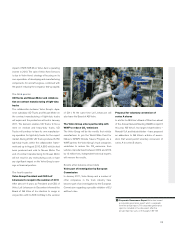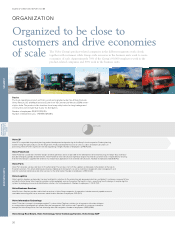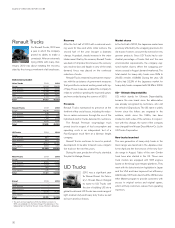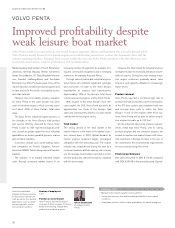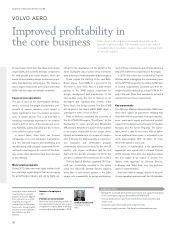Volvo 2010 Annual Report Download - page 32
Download and view the complete annual report
Please find page 32 of the 2010 Volvo annual report below. You can navigate through the pages in the report by either clicking on the pages listed below, or by using the keyword search tool below to find specific information within the annual report.
BOARD OF DIRECTORS’ REPORT 2010
Ambitions 2010
• Capture growth in emerging markets.
• Increase industrial productivity in up-turn.
• Control costs.
• Successful introduction of new engine generations
in the US and Japan.
TRUCKS
During the year, order intake in Europe and North
America increased successively from low initial
levels. The Japanese market grew during the first
half of the year and then stumbled after the gov-
ernment incentive program for investments in
new trucks ceased. Throughout the year, demand
remained strong in many emerging markets,
including Brazil and India.
Total market
The total market for heavy-duty trucks in 2010 in
the 27 EU countries, plus Norway and Switzerland,
amounted to 179,185 vehicles, an increase of 8%
compared with 165,269 vehicles in the preceding
year. The recovery of the European truck market
was divided between North and South and
between fleets and smaller customers, with the
former categories recording stronger growth. In
2011, the European market is estimated to amount
to approximately 220,000 heavy-duty trucks.
In North America, the total market for heavy-
duty trucks (Class 8) increased 20% to 142,096
vehicles, compared with 117,983 in the preceding
year. Viewed as a whole, higher levels of activity
among customers in the long-haulage industry
offset a continued weak market for trucks in the
building and construction industry. In 2011, the
total market in North America is estimated to
amount to approximately 220,000 heavy-duty
trucks.
The total market for heavy-duty trucks in
Japan rose 29% to 24,453 vehicles (18,889).
The Japanese market is expected to grow 10% in
2011. The market for heavy-duty trucks in India
amounted to 211,543 vehicles (125,173), in 2010.
In Brazil, the total market rose 64% to 109,760
heavy-duty trucks (66,950), primarily driven by
the country’s strong economy, but also by advan-
tageous loan terms for investments in new trucks.
Earnings
In 2010, net sales in the truck operations
increased by 20% to SEK 167,305 M (138,940).
The operating income improved to SEK 10,112 M
(loss: 10,805), while the operating margin was
6.0% (neg: 7.8).
The improvement in operating income is princi-
pally due to improved sales and the considerable
cost savings implemented in 2009. Higher
capacity utilization as a side effect of increased
production levels in most plants contributed to
improved operating income.
Volvo Trucks
Volvo Trucks can look back on
a successful 2010 despite
difficult market conditions.
Following the financial crisis
in 2009, the employees’ full
commitment assisted in the rapid adaptation to
substantially lower demand in parallel with the
completion of long-term investments in the
future. As a result, Volvo Trucks has exited the
crisis a much stronger company.
Consistent implementation
Cost savings and measures to improve cash flow
were implemented consistently. Breakeven levels
were reduced considerably and maintained at the
new levels through consistent cost discipline.
Non-European markets recovered strongly led by
South America, where Brazil proved extremely
successful and profitable due to the company’s
strong position and presence. Combined with
improved demand in parts of Europe, this resulted
in the company being able to rehire personnel. In
North America, demand for trucks for long-haul-
age transports increased successively through-
out the year.
In 2010, the challenge comprised responding
and adapting delivery capacity to rapidly rising
demand. This was achieved through beneficial
collaboration between employees and suppliers,
which resulted in significantly increased deliver-
ies and growing market shares. Also, delivery
times were kept relatively short.
The truck operations consist
of Volvo Trucks, Renault
Trucks, UD Trucks, Mack
Trucks and VECV in India
(50% direct and indirect
ownership). The product
offer stretches from heavy-
duty trucks for long-haulage
and construction work to
light-duty trucks for distri-
bution.
Number of employees
38,533
Position on world market
In total, the Volvo Group is Europe’s
largest and the world’s second larg-
est Western manufacturer of heavy
trucks.
Brands
Volvo, Renault, UD, Mack and Eicher.
Staffan Jufors
President of Volvo
Trucks.
Stefano Chmielewski
President of Renault Trucks.
Dennis Slagle
President and CEO of
North American Trucks.
Strong earnings improvement
2010 was characterized by a recovery in demand in the Group’s mature markets
and continued strong growth in the emerging markets.
Pär Östberg
President of Trucks Asia.
28


